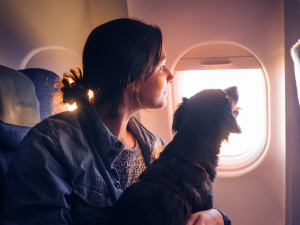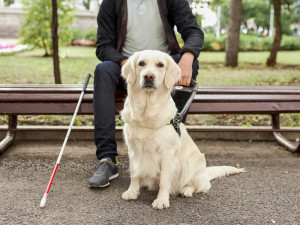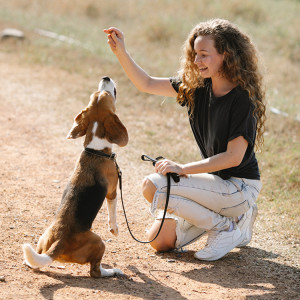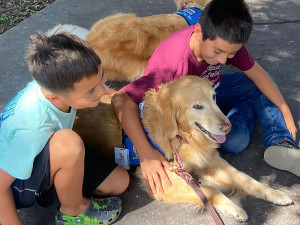How to Register Your Dog as a Service Dog
The short answer: No animal registration is required, but service dogs still need to be properly trained.
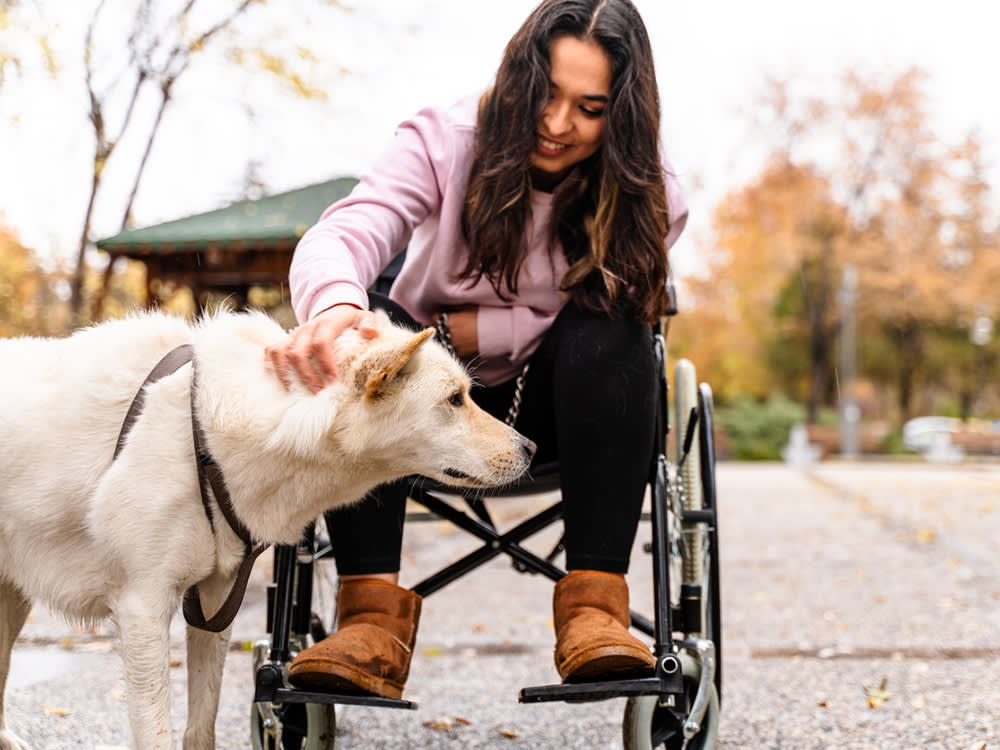
share article

Your pet wants you to read our newsletter. (Then give them a treat.)
Chances are you’ve seen a service dog in the grocery store or while waiting to board your plane at the airport, and you’ve resisted the very powerful urge to petopens in a new tab said dog and tell them how very good they are. After all, service dogs have incredibly important jobs —they’re trained to help people with disabilities navigate the world and maintain their health. But Morgan Donahue, owner and trainer at Feywild Dog Trainingopens in a new tab in Elgin, Illinois, says that their role is even larger than that.
“People think that service dogs are just for blind people or just for military veterans,” Donahue says. “Service dogs can help with a wide variety of disabilities. Some of these disabilities you can see, and some are invisible from the outside. Keep in mind that disability does not ‘look’ a certain way. If someone doesn’t ‘look like they need a service dog’ to you, you may be missing a big part of the picture. But what does it take for a dog to become a service animal? Do they have to go through some sort of dog registration?
While a simple Google search will bring up dozens of websites that promise to register your dog online for a fee, the truth is that no animal registration is requiredopens in a new tab by the Americans with Disabilities Act (ADA). Service dogs go through extensive training to learn how to do things like guide people with visual impairments or watch for signs of seizures — and that training process can take as much as two years. There’s a ton of work that goes into training a puppy to be a service dog and to ensure that they’re prepared for these jobs and can perform their duties flawlessly. After all, lives may depend on these animals — and often do.
“At the end of the day, these pups are highly trained medical devices, not your average well-behaved pet,” Donahue says.
The Wildest explores the importance of proper training for service dogs, whether you can register a service dog online, and how an adorable puppy can become a hardworking service animal.
Why Service Dogs Must Be Trained
A service dog is more than a companion animal. These animals must be able to take care of humans with disabilities and illnesses, which can involve detecting low or high blood sugar in diabetics, helping the visually impaired navigate the world, and assisting hard-of-hearing individuals.
“Service dogs are an incredibly dynamic tool,” Donahue says. “They can sense oncoming medical episodes, provide mobility support, snap a handler out of a panic attack, retrieve items from the ground, and so much more. A single service dog can take the place of multiple other medical devices, and often do the job more effectively.”
While the ADA does not require you to get your service dog registered, you should make sure to purchase a dog license for your city or town and keep your service animal updated on all vaccinations. Websites that promise to license your dog online tend to be scams because mandatory registration for service animals is illegal. Instead, the ADA just requires that you can answer two questions:
Is the service animal needed because of a disability?
What tasks has the service dog been trained to do?
Anyone can ask you these questions, including retail and restaurant staff, Transport Security Administration (TSA) agents at the airport, and any other people that may encounter your service dog in the course of their daily work. If you have a service dog, you should be able to accurately answer both questions to prove that your dog is, in fact, a service animal.
How to Make Your Dog a Service Dog
Service animals must possess the right temperament to even begin training. They have to be intelligent, friendly, and calm, as well as have a desire to work and do their tasks well. While many breeds can be service dogs, not all breeds are right for every position. For example, a mobility assistance dog often needs to be large enough to open cabinets and turn on lights, so a small dog, such as a Pomeranian or Miniature Poodle, won’t do for this particular service.
Not every dog has the characteristics or ability to become a service dog, and if your pet doesn’t, that’s OK. In fact, as many as 50 percent or more of the dogs enrolled in service dog-training programs end up not being suited to the job.
While you can train your dog to be a service dog on your own, it’s a lot of work and is best done either by or in partnership with a professional who has experience training dogs to assist individuals in need. There are training programs all over the country that can provide your dog with the proper instruction they need to become a service animal.
“Traditional service dog programs are true miracles for the people they serve,” Donahue says. “However, they are not accessible to everyone. For programs that place dogs free of charge, the wait lists are long and often come with very specific requirements for the handler. Sometimes, owner training a service dog is the most accessible option. That’s what [my organization, Feywild Dog Training] is designed to help with!”
The Difference Between a Service Dog and an ESA
An emotional support animal opens in a new tab(ESA) is a type of service animal, but they don’t have the same training as service dogs or the same protections under the law. ESAs are usually prescribed by a mental health professional to provide emotional support to individuals struggling with mental illness. While they can definitely be beneficial, ESAs are generally not trained and therefore are not allowed in as many places as service dogs.
Tips for Training Your Dog as a Service Dog
We recommend enrolling your dog in a service dog-training program to ensure that they have the proper training to do their jobs well. But before you choose a class, here are some tips for determining if your dog is ready to become a service animal:
Take stock of your dog’s abilities and personality.
Your dog may have the right personality to be a service animal, but lack the physical strength or ability, or vice versa.
Potty train your dog.
It may sound like a no-brainer, but your dog has to be potty trainedopens in a new tab before they can be trained as a service animal.
Spend time socializing your dog.
Service animals spend a lot of time in unfamiliar environments, dealing with new people, sounds, and smells. To be a service dog, your dog has to be comfortable with the unexpected and not easily distracted.
Know the law and do your research.
Avoid any training programs that promise certification and look for programs with the proper experience. Ask for testimonials from other pet parents or disabled individuals.
Consider requesting an already-trained service dog.
If you’re in need of a service dog, the best thing you can do is request a dog that has already gone through a training program. It’s much easier to work with a dog who has learned how to help you than to train your dog from scratch, but keep in mind that waiting lists for trained service dogs tend to be long, and paying for a fully trained dog can cost anywhere from $10,000 to $50,000.
Work with a trainer.
If you don’t have the budget to pay for service dog training, consider working with a service dog trainer who assists disabled individuals in the process of training their own dogs. They can guide you, whether through the entire training journey or just to help out with issues along the way.

Savannah Admire
Savannah Admire is a writer, editor, and pet parent to two dogs and a cat. When she’s not writing, you can find her reading, playing Animal Crossing, or being an obnoxious nerd about her favorite movies and TV shows. She lives in Maryland, where she constantly debates whether or not to get a third dog.
Related articles
![Female dog trainer raising a treat above a beagle dog's head]() opens in a new tab
opens in a new tabYour Dog’s Trauma Triggers Are Everywhere. Fear-Free Training Can Help
“America’s Veterinarian” and the founder of Fear Free Pets, Dr. Marty Becker, on how this method makes vet visits, training sessions, and grooming appointments less stressful for pets.
![A red haired woman dog trainer kneeling in front of a Shepherd mixed breed dog with one finger raised that the dog is looking at in an outdoor training course.]() opens in a new tab
opens in a new tabUnderstanding Popular Dog Training Methods
Look behind the advertising language when picking a dog trainer.
![Two young boys hugging a comfort dog on the pavement outside]() opens in a new tab
opens in a new tabUvalde Students Have Some New Pals Going Back to School With Them: Dogs
How Golden Retrievers are helping Uvalde, TX, students return to class after the May 2022 tragedy.
